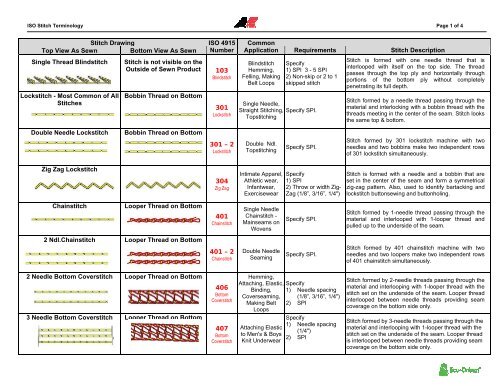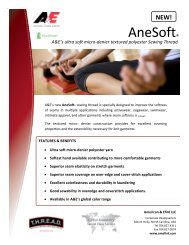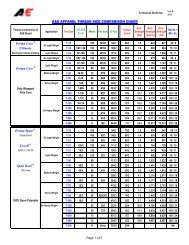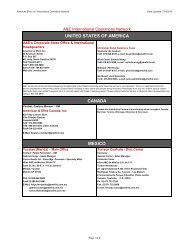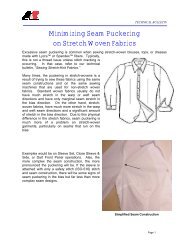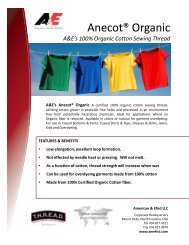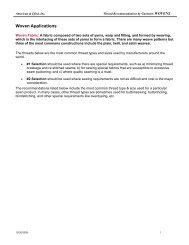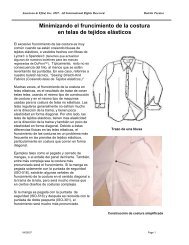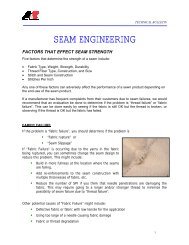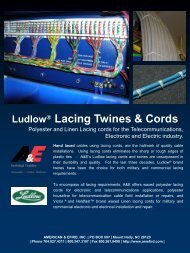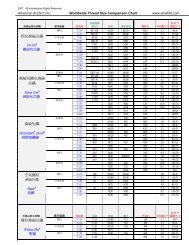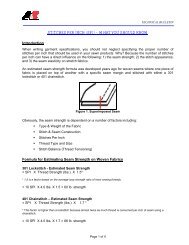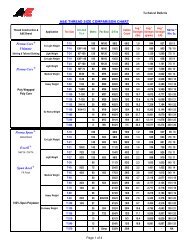Stitch Drawing Top View As Sewn Bottom View As Sewn ISO 4915 ...
Stitch Drawing Top View As Sewn Bottom View As Sewn ISO 4915 ...
Stitch Drawing Top View As Sewn Bottom View As Sewn ISO 4915 ...
Create successful ePaper yourself
Turn your PDF publications into a flip-book with our unique Google optimized e-Paper software.
<strong>ISO</strong> <strong>Stitch</strong> Terminology Page 1 of 4<br />
<strong>Stitch</strong> <strong>Drawing</strong><br />
<strong>Top</strong> <strong>View</strong> <strong>As</strong> <strong>Sewn</strong><br />
<strong>Bottom</strong> <strong>View</strong> <strong>As</strong> <strong>Sewn</strong><br />
Single Thread Blindstitch<br />
Lockstitch - Most Common of All<br />
<strong>Stitch</strong>es<br />
<strong>ISO</strong> <strong>4915</strong><br />
Number<br />
<strong>Stitch</strong> is not visible on the<br />
Outside of <strong>Sewn</strong> Product 103<br />
Blindstitch<br />
Bobbin Thread on <strong>Bottom</strong><br />
301<br />
Lockstitch<br />
Common<br />
Application Requirements <strong>Stitch</strong> Description<br />
Blindstitch<br />
Hemming,<br />
Felling, Making<br />
Belt Loops<br />
Specify<br />
1) SPI 3 - 5 SPI<br />
2) Non-skip or 2 to 1<br />
skipped stitch<br />
Single Needle,<br />
Straight <strong>Stitch</strong>ing, Specify SPI.<br />
<strong>Top</strong>stitching<br />
<strong>Stitch</strong> is formed with one needle thread that is<br />
interlooped with itself on the top side. The thread<br />
passes through the top ply and horizontally through<br />
portions of the bottom ply without completely<br />
penetrating its full depth.<br />
<strong>Stitch</strong> formed by a needle thread passing through the<br />
material and interlocking with a bobbin thread with the<br />
threads meeting in the center of the seam. <strong>Stitch</strong> looks<br />
the same top & bottom.<br />
Double Needle Lockstitch<br />
Bobbin Thread on <strong>Bottom</strong><br />
301 – 2<br />
Lockstitch<br />
Double Ndl.<br />
<strong>Top</strong>stitching<br />
Specify SPI.<br />
<strong>Stitch</strong> formed by 301 lockstitch machine with two<br />
needles and two bobbins make two independent rows<br />
of 301 lockstitch simultaneously.<br />
Zig Zag Lockstitch<br />
304<br />
Zig Zag<br />
Intimate Apparel,<br />
Athletic wear,<br />
Infantwear,<br />
Exercisewear<br />
Specify<br />
1) SPI<br />
2) Throw or width Zig-<br />
Zag (1/8”, 3/16”, 1/4")<br />
<strong>Stitch</strong> is formed with a needle and a bobbin that are<br />
set in the center of the seam and form a symmetrical<br />
zig-zag pattern. Also, used to identify bartacking and<br />
lockstitch buttonsewing and buttonholing.<br />
Chainstitch<br />
Looper Thread on <strong>Bottom</strong><br />
401<br />
Chainstitch<br />
Single Needle<br />
Chainstitch -<br />
Mainseams on<br />
Wovens<br />
Specify SPI.<br />
<strong>Stitch</strong> formed by 1-needle thread passing through the<br />
material and interlooped with 1-looper thread and<br />
pulled up to the underside of the seam.<br />
2 Ndl.Chainstitch Looper Thread on <strong>Bottom</strong><br />
401 – 2<br />
Chainstitch<br />
Double Needle<br />
Seaming<br />
Specify SPI.<br />
<strong>Stitch</strong> formed by 401 chainstitch machine with two<br />
needles and two loopers make two independent rows<br />
of 401 chainstitch simultaneously.<br />
2 Needle <strong>Bottom</strong> Coverstitch Looper Thread on <strong>Bottom</strong><br />
3 Needle <strong>Bottom</strong> Coverstitch Looper Thread on <strong>Bottom</strong><br />
406<br />
<strong>Bottom</strong><br />
Coverstitch<br />
407<br />
<strong>Bottom</strong><br />
Coverstitch<br />
Hemming,<br />
Attaching, Elastic, Specify<br />
Binding,<br />
Coverseaming,<br />
1) Needle spacing<br />
(1/8”, 3/16”, 1/4")<br />
Making Belt<br />
Loops<br />
2) SPI<br />
Attaching Elastic<br />
to Men's & Boys<br />
Knit Underwear<br />
Specify<br />
1) Needle spacing<br />
(1/4")<br />
2) SPI<br />
<strong>Stitch</strong> formed by 2-needle threads passing through the<br />
material and interlooping with 1-looper thread with the<br />
stitch set on the underside of the seam. Looper thread<br />
interlooped between needle threads providing seam<br />
coverage on the bottom side only.<br />
<strong>Stitch</strong> formed by 3-needle threads passing through the<br />
material and interlooping with 1-looper thread with the<br />
stitch set on the underside of the seam. Looper thread<br />
is interlooped between needle threads providing seam<br />
coverage on the bottom side only.
<strong>ISO</strong> <strong>Stitch</strong> Terminology Page 2 of 4<br />
<strong>Stitch</strong> <strong>Drawing</strong><br />
<strong>Top</strong> <strong>View</strong> <strong>As</strong> <strong>Sewn</strong><br />
<strong>Bottom</strong> <strong>View</strong> <strong>As</strong> <strong>Sewn</strong><br />
Single "purl" on Edge<br />
2 Thread Overedge<br />
<strong>ISO</strong> <strong>4915</strong><br />
Number<br />
503<br />
1 Ndl.<br />
Common<br />
Application Requirements <strong>Stitch</strong> Description<br />
Serging &<br />
Blindhemming<br />
Specify<br />
1) Width Bite (Ex.<br />
1/8", 3/16", 1/4")<br />
2) SPI.<br />
<strong>Stitch</strong> formed by 1-needle thread and 1-looper thread<br />
with purl on edge of seam for serging or blindhemming<br />
ONLY.<br />
3 Thread Overedge Common Overedge <strong>Stitch</strong><br />
504<br />
1 Ndl.<br />
Single Needle<br />
Overedge<br />
Seaming<br />
Specify<br />
1) Width Bite (Ex.<br />
1/8", 3/16", 1/4")<br />
2) SPI.<br />
<strong>Stitch</strong> formed with 1-needle thread and 2-looper threads<br />
with the looper threads forming a purl on the edge of the<br />
seam. For overedge seaming and serging.<br />
3 Thread Overedge Double "purl" on Edge<br />
505<br />
1 Ndl.<br />
Dbl. Purl<br />
Serging with<br />
Double purl on<br />
Edge<br />
Specify<br />
1) Width Bite (Ex.<br />
1/8", 3/16", 1/4")<br />
2) SPI.<br />
<strong>Stitch</strong> formed with 1-needle thread and 2-looper threads<br />
with the looper threads forming a double purl on the<br />
edge of the seam for serging ONLY.<br />
Mock Safety <strong>Stitch</strong><br />
2 Needle Overedge<br />
2 Needle 4 Thread Overedge 2 Needle Overedge<br />
4 Thread Safetystitch<br />
5 Thread Safetystitch<br />
512<br />
2 Ndl.<br />
514<br />
2 Ndl.<br />
515<br />
(401+503)<br />
Safetystitch<br />
516<br />
(401+504)<br />
Safetystitch<br />
Seaming Stretch<br />
Knits, Wovens<br />
Seaming Stretch<br />
Knits, Wovens<br />
Safetystitch<br />
Seaming Wovens<br />
& Knits<br />
Safety <strong>Stitch</strong><br />
Seaming Wovens<br />
& Knits<br />
Specify SPI.<br />
Specify SPI.<br />
Specify<br />
1) Needle spacing &<br />
bite - Ex.: 1/8”-<br />
1/8", 3/16”- 3/16"’<br />
3/16” – 1/4"<br />
2) SPI<br />
Specify<br />
3) Needle spacing &<br />
bite - Ex.: 1/8”-<br />
1/8", 3/16”- 3/16"’<br />
3/16” – 1/4"<br />
4) SPI<br />
<strong>Stitch</strong> formed with 2-needle threads and 2 looper<br />
threads with the looper threads forming a purl on the<br />
edge of the seam. 512 – right needle only enters the<br />
upper looper loop. <strong>Stitch</strong> does NOT chain-off as well as<br />
514 <strong>Stitch</strong><br />
<strong>Stitch</strong> formed with 2-needle threads and 2 looper<br />
threads with the looper threads forming a purl on the<br />
edge of the seam. 514 – both needles enter the upper<br />
looper loop. Preferred over 512 <strong>Stitch</strong> because it chainsoff<br />
better.<br />
Combination stitch consisting of a single-needle<br />
chainstitch (401) and a 2-thread Overedge stitch (503)<br />
that are formed simultaneously. Uses less thread than a<br />
516 stitch; however, many manufacturers prefer a 516<br />
stitch.<br />
Combination stitch consisting of a single-needle<br />
chainstitch (401) and a 3-thread Overedge stitch (504)<br />
that are formed simultaneously.
<strong>ISO</strong> <strong>Stitch</strong> Terminology Page 3 of 4<br />
<strong>Stitch</strong> <strong>Drawing</strong><br />
<strong>Top</strong> <strong>View</strong> <strong>As</strong> <strong>Sewn</strong><br />
<strong>Bottom</strong> <strong>View</strong> <strong>As</strong> <strong>Sewn</strong><br />
2 Needle 4 Thread Coverstitch<br />
3 Needle 5 Thread Coverstitch<br />
<strong>ISO</strong> <strong>4915</strong><br />
Number<br />
602<br />
Coverstitch<br />
605<br />
Coverstitch<br />
Common<br />
Application Requirements <strong>Stitch</strong> Description<br />
Binding A Shirts,<br />
Infants Clothing,<br />
etc.<br />
Lap Seaming,<br />
Coverseaming,<br />
Binding on Knits<br />
Specify<br />
1) Needle spacing<br />
(Ex: 1/8", 3/16",<br />
1/4")<br />
2) SPI<br />
Specify<br />
1) Needle spacing<br />
(Ex: 1/4")<br />
2) SPI<br />
<strong>Stitch</strong> formed with 2-needle threads, a top cover thread<br />
and a bottom looper thread.<br />
<strong>Stitch</strong> formed with 3-needle threads, a top cover thread<br />
and a bottom looper thread.<br />
4 Needle 6 Thread Coverstitch Flatseamer/Flatlock<br />
607<br />
Flatseam<br />
Coverstitch<br />
Flat or Lap<br />
Seaming Knit<br />
Underwear,<br />
Fleece, etc.<br />
Specify SPI<br />
<strong>Stitch</strong> formed with 4-needle threads, a top cover thread<br />
and a bottom looper thread. Preferred over 606 stitch<br />
because machines are easier to maintain.<br />
BUTTONSEW, BUTTONHOLE, BARTACK<br />
<strong>Stitch</strong> Appearance<br />
<strong>ISO</strong> <strong>4915</strong><br />
Number<br />
Common<br />
Application Requirements <strong>Stitch</strong> Description<br />
Lockstitch Buttonsew,<br />
Buttonhole or Bartack<br />
Single Thread Chainstitch<br />
Buttonsew<br />
* 304 Lockstitch is<br />
preferred when stitch<br />
security is a Must.<br />
101 chainstitch Buttonsew<br />
with single thread<br />
304<br />
Lockstitch<br />
101<br />
Chainstitch<br />
Buttonsew<br />
Buttonhole<br />
Bartack<br />
1) Buttonsew -<br />
specify stitches<br />
per cycle (Ex.<br />
8,16, 32)<br />
2) BH - specify length<br />
& width (1/2”, 3/4",<br />
1” )<br />
3) Bartack – specify<br />
the length & width<br />
of the tack<br />
Buttonsewing can be done with either a single thread<br />
buttonsewer or a lockstitch buttonsewer. Because<br />
single thread sewn buttons can unravel if the stitch is<br />
not locked properly, lockstitch sewn buttons is often<br />
preferred. 2 hole buttons are usually sewn with 6 or 8<br />
stitches. 4 hole buttons are normally sewn with 12 or<br />
16 stitches.<br />
Knit Shirts - Buttonhole length generally is 1/2 inch, is<br />
placed horizontally, with approximately 85-90 stitches.<br />
Most common bartack machines sew tacks with 28<br />
stitches. Usually this includes running stitches that are<br />
then overlayed with cross-over stitches.
<strong>ISO</strong> <strong>Stitch</strong> Terminology Page 4 of 4


